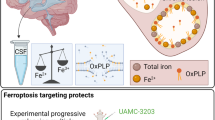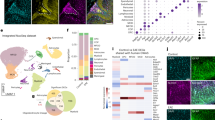Abstract
Relapses and disease exacerbations are vexing features of multiple sclerosis. Osteopontin (Opn), which is expressed in multiple sclerosis lesions, is increased in patients’ plasma during relapses. Here, in models of multiple sclerosis including relapsing, progressive and multifocal experimental autoimmune encephalomyelitis (EAE), Opn triggered recurrent relapses, promoted worsening paralysis and induced neurological deficits, including optic neuritis. Increased inflammation followed Opn administration, whereas its absence resulted in more cell death of brain-infiltrating lymphocytes. Opn promoted the survival of activated T cells by inhibiting the transcription factor Foxo3a, by activating the transcription factor NF-κB through induction of phosphorylation of the kinase IKKβ and by altering expression of the proapoptotic proteins Bim, Bak and Bax. Those mechanisms collectively suppressed the death of myelin-reactive T cells, linking Opn to the relapses and insidious progression characterizing multiple sclerosis.
This is a preview of subscription content, access via your institution
Access options
Subscribe to this journal
Receive 12 print issues and online access
$209.00 per year
only $17.42 per issue
Buy this article
- Purchase on Springer Link
- Instant access to full article PDF
Prices may be subject to local taxes which are calculated during checkout





Similar content being viewed by others
References
National Institutes of Health Autoimmune Disease Coordinating Committee Report (The National Institutes of Health, Bethesda, Maryland 2002).
Denhardt, D.T., Noda, M., O'Regan, A.W., Pavlin, D. & Berman, J.S. Osteopontin as a means to cope with environmental insults: regulation of inflammation, tissue remodeling, and cell survival. J. Clin. Invest. 107, 1055–1061 (2001).
Shinohara, M.L. et al. Osteopontin expression is essential for interferon-α production by plasmacytoid dendritic cells. Nat. Immunol. 7, 498–506 (2006).
Chabas, D. et al. The influence of the proinflammatory cytokine, osteopontin, on autoimmune demyelinating disease. Science 294, 1731–1735 (2001).
Comabella, M. et al. Plasma osteopontin levels in multiple sclerosis. J. Neuroimmunol. 158, 231–239 (2005).
Wong, C.K., Lit, L.C., Tam, L.S., Li, E.K. & Lam, C.W. Elevation of plasma osteopontin concentration is correlated with disease activity in patients with systemic lupus erythematosus. Rheumatology (Oxford) 44, 602–606 (2005).
Lampe, M.A., Patarca, R., Iregui, M.V. & Cantor, H. Polyclonal B cell activation by the Eta-1 cytokine and the development of systemic autoimmune disease. J. Immunol. 147, 2902–2906 (1991).
Xu, G. et al. Role of osteopontin in amplification and perpetuation of rheumatoid synovitis. J. Clin. Invest. 115, 1060–1067 (2005).
Chiocchetti, A. et al. High levels of osteopontin associated with polymorphisms in its gene are a risk factor for development of autoimmunity/lymphoproliferation. Blood 103, 1376–1382 (2004).
Sato, T. et al. Osteopontin/Eta-1 upregulated in Crohn's disease regulates the Th1 immune response. Gut 54, 1254–1262 (2005).
Jansson, M., Panoutsakopoulou, V., Baker, J., Klein, L. & Cantor, H. Cutting edge: Attenuated experimental autoimmune encephalomyelitis in eta-1/osteopontin-deficient mice. J. Immunol. 168, 2096–2099 (2002).
Vogt, M.H. et al. Osteopontin levels and increased disease activity in relapsing-remitting multiple sclerosis patients. J. Neuroimmunol. 155, 155–160 (2004).
Ashkar, S. et al. Eta-1 (osteopontin): an early component of type-1 (cell-mediated) immunity. Science 287, 860–864 (2000).
O'Regan, A.W., Nau, G.J., Chupp, G.L. & Berman, J.S. Osteopontin (Eta-1) in cell-mediated immunity: teaching an old dog new tricks. Immunol. Today 21, 475–478 (2000).
Shinohara, M.L. et al. T-bet-dependent expression of osteopontin contributes to T cell polarization. Proc. Natl. Acad. Sci. USA 102, 17101–17106 (2005).
Scatena, M. et al. NF-κB mediates αvβ3 integrin-induced endothelial cell survival. J. Cell Biol. 141, 1083–1093 (1998).
Lin, Y.H. et al. Coupling of osteopontin and its cell surface receptor CD44 to the cell survival response elicited by interleukin-3 or granulocyte-macrophage colony-stimulating factor. Mol. Cell. Biol. 20, 2734–2742 (2000).
Walker, L.S. & Abbas, A.K. The enemy within: keeping self-reactive T cells at bay in the periphery. Nat. Rev. Immunol. 2, 11–19 (2002).
Pender, M.P., Nguyen, K.B., McCombe, P.A. & Kerr, J.F. Apoptosis in the nervous system in experimental allergic encephalomyelitis. J. Neurol. Sci. 104, 81–87 (1991).
Gold, R., Hartung, H.P. & Lassmann, H. T-cell apoptosis in autoimmune diseases: termination of inflammation in the nervous system and other sites with specialized immune-defense mechanisms. Trends Neurosci. 20, 399–404 (1997).
Tabi, Z., McCombe, P.A. & Pender, M.P. Apoptotic elimination of Vβ8.2+ cells from the central nervous system during recovery from experimental autoimmune encephalomyelitis induced by the passive transfer of Vβ8.2+ encephalitogenic T cells. Eur. J. Immunol. 24, 2609–2617 (1994).
Steinman, L. Multiple sclerosis: a two-stage disease. Nat. Immunol. 2, 762–764 (2001).
Bettelli, E. et al. Myelin oligodendrocyte glycoprotein-specific T cell receptor transgenic mice develop spontaneous autoimmune optic neuritis. J. Exp. Med. 197, 1073–1081 (2003).
Das, R., Mahabeleshwar, G.H. & Kundu, G.C. Osteopontin stimulates cell motility and nuclear factor κB-mediated secretion of urokinase type plasminogen activator through phosphatidylinositol 3-kinase/Akt signaling pathways in breast cancer cells. J. Biol. Chem. 278, 28593–28606 (2003).
Lin, Y.H. & Yang-Yen, H.F. The osteopontin-CD44 survival signal involves activation of the phosphatidylinositol 3-kinase/Akt signaling pathway. J. Biol. Chem. 276, 46024–46030 (2001).
Brunet, A. et al. Akt promotes cell survival by phosphorylating and inhibiting a Forkhead transcription factor. Cell 96, 857–868 (1999).
Medema, R.H., Kops, G.J., Bos, J.L. & Burgering, B.M. AFX-like Forkhead transcription factors mediate cell-cycle regulation by Ras and PKB through p27kip1. Nature 404, 782–787 (2000).
Hu, M.C. et al. IκB kinase promotes tumorigenesis through inhibition of forkhead FOXO3a. Cell 117, 225–237 (2004).
Essafi, A. et al. Direct transcriptional regulation of Bim by FoxO3a mediates STI571-induced apoptosis in Bcr-Abl-expressing cells. Oncogene 24, 2317–2329 (2005).
Hoffmann, A. & Baltimore, D. Circuitry of nuclear factor κB signaling. Immunol. Rev. 210, 171–186 (2006).
Strasser, A. & Pellegrini, M. T-lymphocyte death during shutdown of an immune response. Trends Immunol. 25, 610–615 (2004).
Cheng, E.H. et al. BCL-2, BCL-X(L) sequester BH3 domain-only molecules preventing BAX- and BAK-mediated mitochondrial apoptosis. Mol. Cell 8, 705–711 (2001).
Marrack, P. & Kappler, J. Control of T cell viability. Annu. Rev. Immunol. 22, 765–787 (2004).
Susin, S.A. et al. Molecular characterization of mitochondrial apoptosis-inducing factor. Nature 397, 441–446 (1999).
Lakhani, S.A. et al. Caspases 3 and 7: key mediators of mitochondrial events of apoptosis. Science 311, 847–851 (2006).
Munoz-Pinedo, C. et al. Different mitochondrial intermembrane space proteins are released during apoptosis in a manner that is coordinately initiated but can vary in duration. Proc. Natl. Acad. Sci. USA 103, 11573–11578 (2006).
Lipton, S.A. & Bossy-Wetzel, E. Dueling activities of AIF in cell death versus survival: DNA binding and redox activity. Cell 111, 147–150 (2002).
Steinman, L., Martin, R., Bernard, C., Conlon, P. & Oksenberg, J.R. Multiple sclerosis: deeper understanding of its pathogenesis reveals new targets for therapy. Annu. Rev. Neurosci. 25, 491–505 (2002).
Brocke, S. et al. Induction of relapsing paralysis in experimental autoimmune encephalomyelitis by bacterial superantigen. Nature 365, 642–644 (1993).
Yu, M., Johnson, J.M. & Tuohy, V.K. A predictable sequential determinant spreading cascade invariably accompanies progression of experimental autoimmune encephalomyelitis: a basis for peptide-specific therapy after onset of clinical disease. J. Exp. Med. 183, 1777–1788 (1996).
Smith, P.A. et al. Epitope spread is not critical for the relapse and progression of MOG 8–21 induced EAE in Biozzi ABH mice. J. Neuroimmunol. 164, 76–84 (2005).
Skundric, D.S. et al. Distinct immune regulation of the response to H-2b restricted epitope of MOG causes relapsing-remitting EAE in H-2b/s mice. J. Neuroimmunol. 136, 34–45 (2003).
Screaton, G. & Xu, X.N. T cell life and death signalling via TNF-receptor family members. Curr. Opin. Immunol. 12, 316–322 (2000).
Letterio, J.J. TGF-β signaling in T cells: roles in lymphoid and epithelial neoplasia. Oncogene 24, 5701–5712 (2005).
Yu, X.Q. et al. IL-1 up-regulates osteopontin expression in experimental crescentic glomerulonephritis in the rat. Am. J. Pathol. 154, 833–841 (1999).
Palmer, E.M., Farrokh-Siar, L., Maguire van Seventer, J. & van Seventer, G.A. IL-12 decreases activation-induced cell death in human naive Th cells costimulated by intercellular adhesion molecule-1. I. IL-12 alters caspase processing and inhibits enzyme function. J. Immunol. 167, 749–758 (2001).
Han, J. et al. Differential involvement of Bax and Bak in TRAIL-mediated apoptosis of leukemic T cells. Leukemia 18, 1671–1680 (2004).
Adler, B., Ashkar, S., Cantor, H. & Weber, G.F. Costimulation by extracellular matrix proteins determines the response to TCR ligation. Cell. Immunol. 210, 30–40 (2001).
Wittig, B.M., Johansson, B., Zoller, M., Schwarzler, C. & Gunthert, U. Abrogation of experimental colitis correlates with increased apoptosis in mice deficient for CD44 variant exon 7 (CD44v7). J. Exp. Med. 191, 2053–2064 (2000).
Youssef, S. et al. The HMG-CoA reductase inhibitor, atorvastatin, promotes a Th2 bias and reverses paralysis in central nervous system autoimmune disease. Nature 420, 78–84 (2002).
Acknowledgements
We thank G.R. Crabtree, P.P. Jones, P.J. Utz, T.W. Mak (University of Toronto) and D.R. Green (St. Jude Children's Research Hospital) for discussions; J.H. Kim, M.J. Eaton and C.K. Chung for technical assistance; C.J. Shabrami and M.M. Winslow for critical review of the manuscript; S. Rittling and D.T. Denhardt (Rutgers University) for Opn-knockout mice; and V. Kuchroo (Harvard University) for 2D2 mice. Supported by the National Health Institutes, the National Multiple Sclerosis Society, the Phil N. Allen Trust, a Stanford Graduate Fellowship (E.M.H.), a Korean Government Overseas Scholarship (E.M.H.) and a National Multiple Sclerosis Society Career Transitional Award (S.Y.).
Author information
Authors and Affiliations
Contributions
E.M.H. and S.Y. designed and did the experiments and prepared the manuscript; M.E.H. assisted with cell fractionation; S.Y.Z. assisted in assigning scores to mice with EAE; R.A.S. contributed to histology; and L.S. supervised all studies and preparation of the manuscript.
Corresponding author
Ethics declarations
Competing interests
The authors declare no competing financial interests.
Supplementary information
Supplementary Fig. 1
Autoimmune optic neuritis induced by OPN in MOG-specific TCR transgenic mice with EAE. (PDF 2949 kb)
Supplementary Fig. 2
Residual LPS in purified OPN does not affect clinical score of EAE. (PDF 410 kb)
Supplementary Fig. 3
Increased T cell proliferation by OPN. (PDF 234 kb)
Supplementary Fig. 4
The time course expression of Bim, Bak and Bax after T cell activation in vitro. (PDF 1562 kb)
Supplementary Fig. 5
OPN does not affect Fas-induced cell death. (PDF 252 kb)
Supplementary Fig. 6
OPN inhibits nuclear translocation of AIF. (PDF 1623 kb)
Supplementary Fig. 7
Schematic diagram of OPN-induced survival of T cell. (PDF 581 kb)
Supplementary Fig. 8
Schematic diagram of the suggested model for autoimmune relapse. (PDF 778 kb)
Supplementary Table 1
EAE induced in OPN-KO and OPN-WT mice. (PDF 59 kb)
Rights and permissions
About this article
Cite this article
Hur, E., Youssef, S., Haws, M. et al. Osteopontin-induced relapse and progression of autoimmune brain disease through enhanced survival of activated T cells. Nat Immunol 8, 74–83 (2007). https://doi.org/10.1038/ni1415
Received:
Accepted:
Published:
Issue Date:
DOI: https://doi.org/10.1038/ni1415
This article is cited by
-
FoxO3 and oxidative stress: a multifaceted role in cellular adaptation
Journal of Molecular Medicine (2023)
-
Tissue-resident immune cells in the pathogenesis of multiple sclerosis
Inflammation Research (2023)
-
Single-cell and spatial RNA sequencing identify perturbators of microglial functions with aging
Nature Aging (2022)
-
Osteopontin accumulates in basal deposits of human eyes with age-related macular degeneration and may serve as a biomarker of aging
Modern Pathology (2022)
-
Inflammasome Signaling in the Aging Brain and Age-Related Neurodegenerative Diseases
Molecular Neurobiology (2022)



